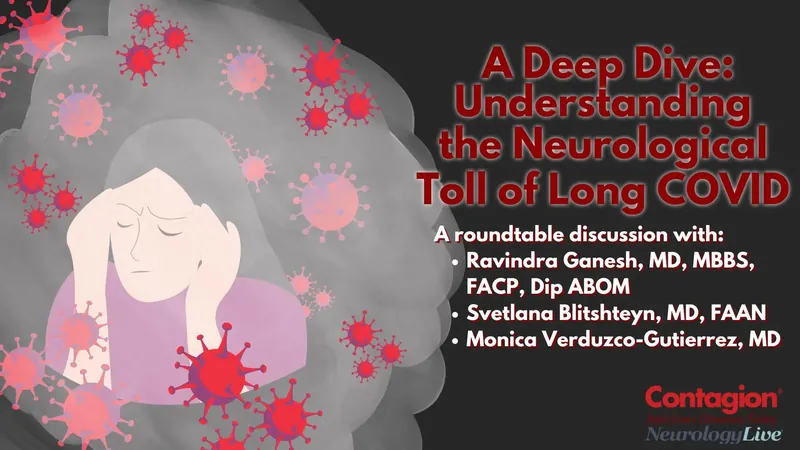
Unraveling the Mysteries of Long COVID: Challenges and Emerging Insights in Treatment
2024-10-25
Author: Siti
Introduction
The COVID-19 pandemic has left behind a troubling legacy known as Long COVID, or post-acute sequelae of SARS-CoV-2 infection (PASC). This debilitating condition affects countless individuals globally, manifesting symptoms that persist long after the initial infection. Neurologic issues hold a significant place among these symptoms, including fatigue, cognitive impairment often described as brain fog, sleep disturbances, sensory loss, and more. The World Health Organization estimates that as many as 10-20% of individuals infected with COVID-19 may experience Long COVID, making it a pressing public health concern.
Diagnostic Challenges
Current diagnostic measures for Long COVID remain ambiguous; there are no definitive tests to pinpoint the condition. Clinical features cannot always be linked to specific laboratory findings or biomarkers, making it vital for researchers to develop effective diagnostic tools. The indiscriminate nature of Long COVID emphasizes its capacity to affect anyone, regardless of age or preexisting health conditions, underscoring a considerable psychological and economic burden on society.
Insights from Clinicians
In a recent roundtable discussion hosted by NeurologyLive, esteemed clinicians focusing on Long COVID care shared valuable insights and experiences. The panel included Dr. Ravindra Ganesh from the Mayo Clinic, Dr. Svetlana Blitshteyn from the University at Buffalo, and Dr. Monica Verduzco-Gutierrez from UT Health, all of whom tightly frame their treatment options based on the complex nature of Long COVID symptoms.
Dr. Ganesh pointed out that, since no FDA-approved treatments exist for Long COVID, many approaches currently mimic therapies used for other chronic illnesses. He employs “phenotyping” patients to tailor therapeutic interventions, which may involve using medications like low-dose naltrexone or lifestyle adjustments. Monitoring patients for overexertion is crucial, as pushing too hard may lead to debilitating crashes.
The panel also brought attention to clinical trials, offering hope for the future. Trials like the RECOVER initiative are currently evaluating various treatment options such as intravenous immunoglobulin (IVIG) therapy and antiviral medications. The necessity for these trials cannot be overstated, as they may lead to effective solutions for a condition that has perplexed medical professionals.
Dr. Verduzco-Gutierrez illuminated the importance of identifying patient phenotypes. While no single treatment fits all, she noted that many patients respond well to traditional medications and rehabilitative therapies. Monitoring conditions like post-exertional malaise—where even minimal exertion can exacerbate symptoms—is key. Here, careful adjustments in activity levels and rehabilitation programs can play an essential role in symptom management.
Dr. Blitshteyn raised a critical point about treatment accessibility, lamenting that many patients do not receive adequate care. Standard approaches often focus only on physical therapy or psychotherapy, which may not be sufficient. She urged for a broadened understanding within the medical community about the need for medications in conjunction with other interventions.
Resilience in the face of skepticism poses another hurdle. As reported by Dr. Verduzco-Gutierrez, disbelief in the legitimacy of Long COVID by some clinicians generates additional strain for patients who face dismissal. It highlights the necessity for education across specialties to foster awareness and support for those suffering from this complex syndrome.
Hope for the Future
The collective hope among the panelists is not only for a deeper understanding of Long COVID pathology but also for more treatment options accessible to patients. This includes everything from over-the-counter remedies to advanced immunotherapies that are FDA-approved. Addressing the multifactorial nature of symptoms is paramount, as some individuals might experience a confluence of underlying issues such as autoimmunity or mitochondrial dysfunction.
Conclusion
In conclusion, as we continue to navigate the implications of Long COVID, it becomes increasingly evident that this condition requires a tailored, compassionate approach. With ongoing research, improved clinician education, and a commitment to understanding underlying pathophysiology, we stand at the precipice of potentially unlocking effective strategies to alleviate the burden of Long COVID. The journey towards comprehensive care for Long COVID patients starts with recognizing and validating their experiences—viewing them not as individuals defined by their symptoms, but as patients deserving of thorough, personalized treatment.



 Brasil (PT)
Brasil (PT)
 Canada (EN)
Canada (EN)
 Chile (ES)
Chile (ES)
 España (ES)
España (ES)
 France (FR)
France (FR)
 Hong Kong (EN)
Hong Kong (EN)
 Italia (IT)
Italia (IT)
 日本 (JA)
日本 (JA)
 Magyarország (HU)
Magyarország (HU)
 Norge (NO)
Norge (NO)
 Polska (PL)
Polska (PL)
 Schweiz (DE)
Schweiz (DE)
 Singapore (EN)
Singapore (EN)
 Sverige (SV)
Sverige (SV)
 Suomi (FI)
Suomi (FI)
 Türkiye (TR)
Türkiye (TR)